Cape Fear Jetport is one of the state's busiest airports. It's got big plans to do more.

Howie Franklin often tells people that “money doesn’t drive into the Southport-Oak Island area; it flies in.”
As director of the Cape Fear Regional Jetport, it’s something he sees every day. Whether they arrive in personal planes, charters or private jets, Franklin said the weather and the area keep them coming back.
“We have the best weather on the East Coast,” he said. “They love it here.”
The increased traffic means the airport is growing, and expansion is in its future.
Here are four things to know about Cape Fear Jetport and its plans for future growth.
State's fourth busiest airport
Since Brunswick County is the fastest growing county in the state, it’s no surprise its airport is staying busy, too.
A recent report by Aviation Impact Reform, an organization that advocates for transparency and reform of the Federal Aviation Administration, showed Cape Fear Regional Jetport is the fourth busiest airport in the state behind only Charlotte-Douglas International, Raleigh-Durham International, and Piedmont Triad International. The report used the average number of operations — take-offs and landings — performed each day to determine the rankings. Cape Fear Jetport averages 211 operations daily, and of those, about 39 percent are local aircraft.
More from Brunswick County: These 4 Brunswick County towns are among the fastest growing in North Carolina
Franklin noted that since the pandemic, the airport has only become busier.
“The people who normally flew first-class who could afford to charter are now chartering flights,” he explained.
Those charter flights often land and take off from Cape Fear Jetport.

Arrivals convert to revenue
According to a report by the North Carolina Department of Transportation’s Division of Aviation, the airport generates $11.2 million in tax revenue, supports 1,985 jobs, and has an economic impact of $281 million.
Franklin explained one way the airport has contributed to the local economy is by providing a base for several businesses, which he said ensures that it lives up to its mission of being a “public service economic engine.” Currently the airport supports two flight schools, an air tours business, a helicopter tours business, a skydiving operation, and two aircraft mechanic shops.
Other businesses around the airport include a Club Car golf cart retailer located inside the old terminal, an interior design firm and a builder specializing in home improvements, both located in the new terminal.

The 25-year plan
The Cape Fear Jetport recently completed its 25-year plan for capital improvements, which includes the construction an additional 60 hangars.
“And I could fill 40 of them today,” Franklin said.
More on area airports: 'Money flies' in: Wilmington-area airports bring big economic impact
Construction on one of those hangars is through a government contract for Avwatch, a company specializing in the development of aviation technology. Franklin said construction on this hangar will begin as soon as he has the stormwater permit in hand, which is expected to be within the next 30 days.
Other aspects of the plan include an airfield maintenance building, parking improvements, wildlife fencing, and land acquisition for future runway projects.

Any plans for commercial flights?
While the Jetport may be the fourth busiest airport in the state, there are no plans to open it to major commercial flights. Franklin explains he doesn’t think that will ever happen.
“There are no plans for it, mainly because of the geography,” he said.
Cape Fear Jetport is located about 45 minutes south of Wilmington International Airport and about an hour and 20 minutes north of Myrtle Beach International Airport to the south, and both already offer commercial flights.
“Why would they compete with themselves here?” Franklin said. “Now there’s a lot of people that want it, but we will just remain a public service economic engine for the area.”
This article originally appeared on Wilmington StarNews: Cape Fear Jetport among state's busiest airports with plans to expand

